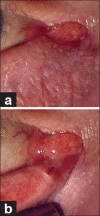Assessment and management of proximal and incomplete symptomatic obstruction of the lacrimal drainage system
- PMID: 22346116
- PMCID: PMC3277026
- DOI: 10.4103/0974-9233.92117
Assessment and management of proximal and incomplete symptomatic obstruction of the lacrimal drainage system
Abstract
Epiphora is a common complaint of patients who present to an Ophthalmology Clinic. In many cases, epiphora is due to an obstruction in the lacrimal drainage system. However, a subgroup of symptomatic patients with epiphora has a patent lacrimal drainage system. Such cases are usually termed 'functional obstruction' and / or 'stenosis of the lacrimal drainage system'. Various etiologies and diagnostic and therapeutic approaches have been described in literature, which implies the lack of a standardized approach. This article will review the evolving diagnostic and therapeutic approaches in literature, and in the end, propose a paradigm in approaching this group of patients.
Keywords: Canalicular stenosis; Epiphora; Functional lacrimal obstruction; Nasolacrimal duct; Punctal stenosis; Stenosis.
Conflict of interest statement
Figures







Similar articles
-
Evaluation and Management of Chemotherapy-Induced Epiphora, Punctal and Canalicular Stenosis, and Nasolacrimal Duct Obstruction.Ophthalmic Plast Reconstr Surg. 2017 Jan/Feb;33(1):9-12. doi: 10.1097/IOP.0000000000000745. Ophthalmic Plast Reconstr Surg. 2017. PMID: 27429222 Review.
-
Management of functional epiphora in patients with an anatomically patent dacryocystorhinostomy.JAMA Ophthalmol. 2014 Sep;132(9):1127-32. doi: 10.1001/jamaophthalmol.2014.1093. JAMA Ophthalmol. 2014. PMID: 24903661
-
Outcomes of lacrimal gland injection of botulinum toxin in functional versus nonfunctional epiphora.Oman J Ophthalmol. 2019 May-Aug;12(2):104-107. doi: 10.4103/ojo.OJO_52_2018. Oman J Ophthalmol. 2019. PMID: 31198296 Free PMC article.
-
Acquired Obliteration of the Proximal Lacrimal Drainage System.Ophthalmic Plast Reconstr Surg. 2019 Jul/Aug;35(4):342-345. doi: 10.1097/IOP.0000000000001244. Ophthalmic Plast Reconstr Surg. 2019. PMID: 30365474
-
Lacrimal outflow mechanisms and the role of scintigraphy: current trends.World J Nucl Med. 2014 Jan;13(1):16-21. doi: 10.4103/1450-1147.138569. World J Nucl Med. 2014. PMID: 25191107 Free PMC article. Review.
Cited by
-
A preliminary study on the clinical characteristics of lacrimal duct obstruction in patients with a history of anterior uveitis.Front Med (Lausanne). 2025 Jul 4;12:1630425. doi: 10.3389/fmed.2025.1630425. eCollection 2025. Front Med (Lausanne). 2025. PMID: 40687721 Free PMC article.
-
Management of acquired punctal stenosis with perforated punctal plugs.Saudi J Ophthalmol. 2015 Jul-Sep;29(3):205-9. doi: 10.1016/j.sjopt.2015.04.001. Epub 2015 May 12. Saudi J Ophthalmol. 2015. PMID: 26155080 Free PMC article.
-
Periorbital facial rejuvenation; applied anatomy and pre-operative assessment.J Curr Ophthalmol. 2017 Apr 25;29(3):154-168. doi: 10.1016/j.joco.2017.04.001. eCollection 2017 Sep. J Curr Ophthalmol. 2017. PMID: 28913505 Free PMC article. Review.
-
Lacrimal Duct Occlusion Is Associated with Infectious Keratitis.Int J Med Sci. 2016 Oct 17;13(10):800-805. doi: 10.7150/ijms.16515. eCollection 2016. Int J Med Sci. 2016. PMID: 27766030 Free PMC article.
-
Outcomes of canalicular trephination versus canaliculodacryocystorhinostomy in common canalicular blocks.Oman J Ophthalmol. 2022 Jun 29;15(2):198-203. doi: 10.4103/ojo.ojo_181_21. eCollection 2022 May-Aug. Oman J Ophthalmol. 2022. PMID: 35937731 Free PMC article.
References
-
- Basic and Clinical course. Section 7, Orbit, Eyelids and Lacrimal System. American Academy of Opthalmology. 2008-2009:259–64.
-
- Basic and Clinical course. Section 2, Fundamentals and Principles of Ophthalmology. American Academy of Opthalmology. 2008-2009:36.
-
- Tucker NA, Tucker SM, Linberg JV. The anatomy of the common canaliculus. Arch Ophthalmol. 1996;114:1231–4. - PubMed
-
- Hirschbein MJ, Stasior GO. In: Oculoplastic surgery, the Essentials. 1st ed. New York: Theime; 2001. Lacrimal System; pp. 263–4.
-
- Takahashi Y, Kakizak H, Nakano T, Asamoto K, Ichinose A, Iwaki M. Anatomy of the vertical lacrimal canaliculus and lacrimal punctum: A macroscopic study. Ophthal Plast Reconstr Surg. 2011;27:384–6. - PubMed
LinkOut - more resources
Full Text Sources
Medical

